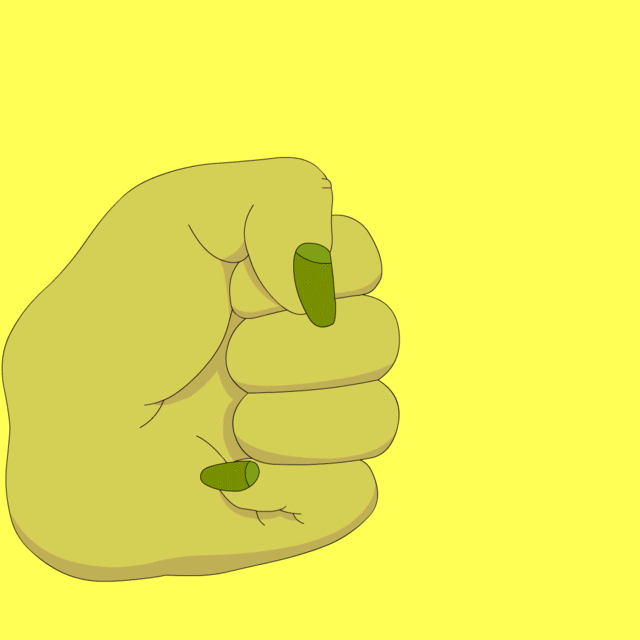
New Feelings About Touch
By Melissa Giannini
Visuals By Brooke DiDonato
We’re all trying to reach out and touch someone—or something—these days. Professional cuddlers comfort the forlorn. A woman called “Bread Face” has become famous for making videos of herself rolling her head in various types of baked goods. Simulating touch is the holy grail for the VR world. Melissa Giannini, who is rediscovering touch through the intimate lens of being a new mother, explores the new tactility.
• • •
Tonight, it’s his gums.
Startled awake by screams, I walk in to find my infant son gnawing on the hard plastic edge of his pacifier, a failed attempt to either coax the tooth out or self-soothe, something I read somewhere that sometimes happens. I’ve also read that it’s important to check on, but not pick up, a 10-month-old who’s having trouble sleeping through the night—that is, if you have any interest in eventually rejoining society as a fully functioning adult human.
I’m a softie, so I scoop him up and kiss his cheek. I can tell the pain is still there, but my physical acknowledgement of it has transformed his wails into teary-eyed giggles. As I nurse and rock him back to sleep, our aching, sleep-deprived bodies melt into a warm, euphoric blob. A rush of oxytocin, otherwise known as the “love hormone,” is at the root of this feeling. Or so I’ve read. Over the past year, I’ve become somewhat obsessed with the power of touch. The strange sensations of carrying, birthing, and feeding my son have all served as a reintroduction to my own body, and now I notice touch—the cultural lack of it and the novel compensations people are making in its absence—everywhere. The tactile sense seems to be in high demand, with Silicon Valley investors and YouTube stars alike trying to satisfy a societal craving for contact. I can’t seem to wrap my mind around how it can be both the most important and yet most underappreciated of the senses. And neither can neurobiologist David J. Linden, who cites the disaster that unfolded in understaffed Romanian orphanages in the 1980s and ’90s in his book Touch: The Science of Hand, Heart and Mind. If deprived of social touch, he writes, a newborn’s growth is slowed, compulsive rocking emerges, and “if not rectified, emergent disorders of mood, cognition, and self-control can persist through adulthood.”

The “social” touch Linden writes about refers to the strokes and caresses of real-life interactions that make us feel supported and cared for. It engages an entirely different set of nerve fibers from the kind of touch that helps us find our way in the dark, teaches infants about the world before they have a grasp of language, and alerts us to something’s temperature or texture. But both are crucial for survival and often conflated. It makes sense that someone might develop a compulsive nonsocial touch behavior like rocking if he or she suffers from social neglect. A famous and deeply sad 1950s experiment involving newborn rhesus monkeys raised by a “wire surrogate” who provided bottled nourishment but no tactile attachment proved as much.
But social touch is just as vital for adults. “When you get older, your access to touch changes, even though your psycho-physiological need for it doesn’t really change,” says Adam Lippin, cofounder and CEO of Cuddlist, a service that connects touch-starved adults with professional cuddlers for therapeutic, nonsexual touch sessions. Indeed, studies have confirmed that healthy levels of physical contact can alleviate stress, pain, and depression and even lead to a decrease in violent behavior. “Without touch, your cortisone levels go up, your stress responses go up. There’s a huge correlation between having human contact and better health,” he says. Researchers from Carnegie Mellon, University of Virginia, and University of Pittsburgh found that hugs help lower a person’s susceptibility to upper respiratory infections.
The desire for touch is so strong—and our lack of it is so rampant—that even virtual and augmented reality engineers want in.
The desire for touch is so strong—and our lack of it so rampant—that even virtual and augmented reality engineers want in. Companies like Ultrahaptics are working on a technology that mimics touch by concentrating and manipulating sound waves so that they can be felt as vibrations against your skin. The gee-whiz fun this could create in VR gaming is obvious, but the technology also has real-world applications. For example, a car dashboard could project and meet a driver’s outstretched hand, where she could then adjust the air-conditioning or radio volume, minimizing the time her eyes are off the road.
Just last month, scientists unveiled the first portable bionic hand that transmits sensations to the brain, as well as an artificial skin for robots that mimics the sensitivities of the real thing via nerve-like channels of electrically conductive liquid metal. In our oversaturated media landscape, advertisers are also on the hunt for a seamless haptics experience. Imagine a future in which you wouldn’t be able to pass a billboard without it reaching out and touching you. Spend five minutes inside a tech conference, and it’s clear: The race to reach a more Star Wars–like reality is on. Why the rush? Because when it comes to creating a truly real virtual experience, touch appears to be the first and final frontier.
If touch is so important, how did we let it out of our grasp? It’s easy to blame technology. From the industrial revolution to automation to artificial intelligence to the wildest theories on interdimensional travel, to go forward has almost always meant to move away from touch. Since the late 1970s, outdoor play has been losing ground to video games. Nowadays, kids are just as entertained by watching other people play video games on YouTube channels like Let’s Play. FaceTime has eclipsed the real thing. In an era of HD, 3D, and VR, our eyes and ears are feasting regularly while our fingers know fewer interesting textures than ever.
In the past 10 years or so, nostalgic trends like steampunk, slow food, hobby farming, and artisanal anything have attempted to provide a counterbalance, and one could argue that candidate Donald Trump’s promises to revitalize “hands-on” industries like manufacturing and coal mining got him elected president. But at the same time, Trump’s embrace of social media is very much of the moment and indicative of how the more we “connect” online, the further we drift from one another in space. In our state of fake news, spin, and bubbles (from dot-com to housing to bitcoin), it’s hard to know what’s real, and it’s easy to succumb to outrage fatigue and the numbing effects of narcotics. All of which combine to make a thorough shampooing at the salon or even a respectful pat-down at the airport—anything that returns the self to corporeality—feel like whiplash.
You could also blame where you live. In the 1960s, when the Internet was still a zygote of an idea, psychologist Sidney Jourard observed conversations between friends at cafés in different parts of the world. He found that acquaintances in the U.S. touched each other twice per hour, while French friends touched each other 110 times, and Puerto Ricans, 180. (For what it’s worth, in the U.K., where in January a minister of loneliness was appointed, friends touched each other zero times.) America’s litigious nature could also be at fault. I have memories of being consoled by a hug from an elementary school teacher, but many schools now outlaw any kind of touching between students and teachers. Maybe for this reason, I couldn’t help but flinch the first time I watched my son’s day care teacher plant a goodbye kiss on his cheek. Now I take comfort in their bond and couldn’t imagine him spending almost 10 hours a day in a place where such an innocent display of affection was shunned.

In Vladimir Nabokov’s Lolita, Humbert Humbert makes a case for the oft-overlooked sense of touch: “It is strange that the tactile sense, which is so infinitely less precious to men than sight, becomes at critical moments our main, if not only, handle to reality.” Nabokov was well aware of its power, but considering the context—i.e., a book about a middle-aged man’s obsession and sexual infatuation with a 12-year-old girl—his words are also imbued with power dynamics, all the more prevalent in the wake of #MeToo.
We’re still coming to terms with the pervasiveness of bad, trauma-causing touch, and there is no shortage of takes on the movement. Whether it’s gone too far or not far enough, the way we view and understand touch has changed forever. And hopefully, what comes out of it is a clearer culture of consent. “Men sometimes take no as an invitation to negotiate or press for what we want,” Lippin says. “And this is not the Harvey Weinsteins, but the people who actually don’t want to be idiots. We’re culturally conditioned to think we need to do this. But people can be taught to honor a no.” And folks can also learn what kind of touch, if any, is OK in the workplace; here, this helpful (truly non-satirical) Daily Mail article notes that “a sudden arm around the shoulder or a pat on the butt isn’t the innocuous gesture some might have thought.”
We're still coming to terms with the pervasiveness of bad, trauma-causing touch.
Between our addiction to social media and the wounds of our culture of coercion, how do we end touch-starvation? We could follow Lippin’s advice and forge deeper human connections while building in more time for consensual touch.
Or we could watch a woman smash her face into baked goods. Bread Face, a Brooklyn-based copywriter in her late 20s who prefers to remain anonymous, has built up a following of 189K on Instagram by doing just that. Calmly and deliberately, she pushes her face into sponge cakes, babka, donuts, and more, rolling her nose and cheeks against the springy desserts. Her reach and impeccable aesthetic have helped her land collaborations with high-end brands like Opening Ceremony and Sidney Garber. Despite their peppy soundtracks and club-ready lighting, Bread Face videos have a soothing or, as she tags it, #oddlysatisfying effect, like slipping into a warm bath.
Hitting a similar, even more anonymous note is the slime video. Slime, like the fidget spinner, started as a tool to help people with autism cope with sensory overload. Lately it’s been embraced by a mainstream populace so hungry for touch, they will sit for hours watching other people play with the stuff. The mesmerizing videos, created by accounts with names like “slimequeeens,” “slime.bun,” and “glitter.slimes,” are almost always well-lit and minimally staged, and typically feature two manicured hands manipulating one brightly colored blob of slime. For full effect, another substance—food coloring, beads, sprinkles, glitter, confetti, or silver dragées—is usually introduced and then kneaded in. The inexplicably pleasant and skin-tingling smooshes and squishes seem to serve as digital antidotes to today’s anxiety-inducing current events, providing a lulling moment of zen for those too impatient to meditate, too lazy for yoga, or too far gone to go outside and interact with another human being.
And like Bread Face, slime-slingers have also picked up on the fact that there’s dough to be made in the nascent simulated-touch service industry. Most accounts link to an e-commerce site where fans can purchase their very own cloud slime or butter slime or Funfetti-scented slime. “How to make slime” was Google’s number-one “how to” search of 2017. Most of those how-tos list Elmer’s as a main ingredient; Fortune reported in June that the glue company’s sales grew by 50% in the first quarter of 2017.
The market for pro-cuddling is also getting crowded. Aside from Cuddlist, there’s Cuddle Party, Japan’s Soineya cuddle café, Cuddle Up to Me studio in Portland, and more, all offering one-on-one time with a professional snuggler, for about $60 to $80 an hour. Before he founded Cuddlist, Lippin spoke with a number of therapists who told him that oftentimes their clients just needed a hug, but they weren’t allowed to give them one. “That’s where the transference, where the real healing work can happen,” he says. “Real work happens beyond words.” Like in the case of a New York resident who hires a Cuddlist once a year, on the anniversary of his brother’s murder; they sit holding hands on a bench in the park where his brother was killed.
“A hundred years ago, a service like this probably wouldn’t have been needed because people lived in very close contact with their tribe or immediate family,” Lippin says. “Now, with planes and traveling for work, it’s more normative than not normative to not live in your hometown.” He also cites device addiction as a force against community creation in environments where, in the past, close friendships were formed, like gyms and colleges. “Our relationship with everything has shifted with the advent of different technologies, and it has tended to increase loneliness,” he says.
One of the more peculiar symptoms of postpartum depression is a surreal, debilitating loneliness. It’s strange mostly because you’re never really alone in the months after giving birth. Even if you aren’t blessed by visits from friends and family, there is, of course, that brand-new living, breathing creature attached to your body nearly 24/7. Most of the baby books suggest new mothers seek out other new moms to socialize and commiserate with. This is great advice, and I started each day of my maternity leave meaning to follow it. But an ever-ratcheting anxiety was conspiring against me.
To cope, I started ordering things online—groceries, diapers, lactation tea, shapeless caftans to hide my still-bloated belly, a leather moto jacket to prove I was still cool. Considering the baby’s two-hour feeding schedule and general fragility in those early weeks, it was difficult to leave the house, yet I craved connection with the outside world. It wasn’t a cheap or environmentally friendly habit, but it worked: The boomerang effect of sending a request out into the void and having the answer appear on my porch in the form of a cardboard box scratched many an itch. Is there anything more satisfying to the tactile sense than popping Bubble Wrap? A more apt way to vent frustration than breaking down a box?
I’m starting to realize that my desire to get back in touch with touch is really a hunt for peace, a moment of stillness, when the world blurs and the air buzzes between the hand of someone I like and my own in the millisecond before they clasp together. It’s an ongoing quest for learning and discovery, like the kind that makes my baby’s eyes light up when his fingers trace new textures in a book about farm animals. And throughout the many ups and downs of the past 10 months, those little hands, gripping the scratchy wool cardigan I wear around the house like a security blanket for us both, have felt like a tether to what’s important.
Maybe that’s why I don’t necessarily mind that I haven’t slept a full eight hours in almost a year, that my shins are perpetually bruised and my toes stubbed from the groggy nightly stumble to my crying son’s room. It’s probably only a matter of weeks until he’s not going to need my soothing touch in the quiet dark of 4 a.m. And then, after that, he’s going to want answers to questions about a world I feel more disconnected from every day, but one that isn’t completely out of reach.
Want to touch this story? Email edit@damnjoan.com with "Touch" in the subject line and your mailing address in the body of the message. We'll send a handmade version of the story to the first 100 people who reach out.
BROOKE DIDONATO is a visual artist from Ohio now living and working in New York City.





